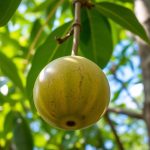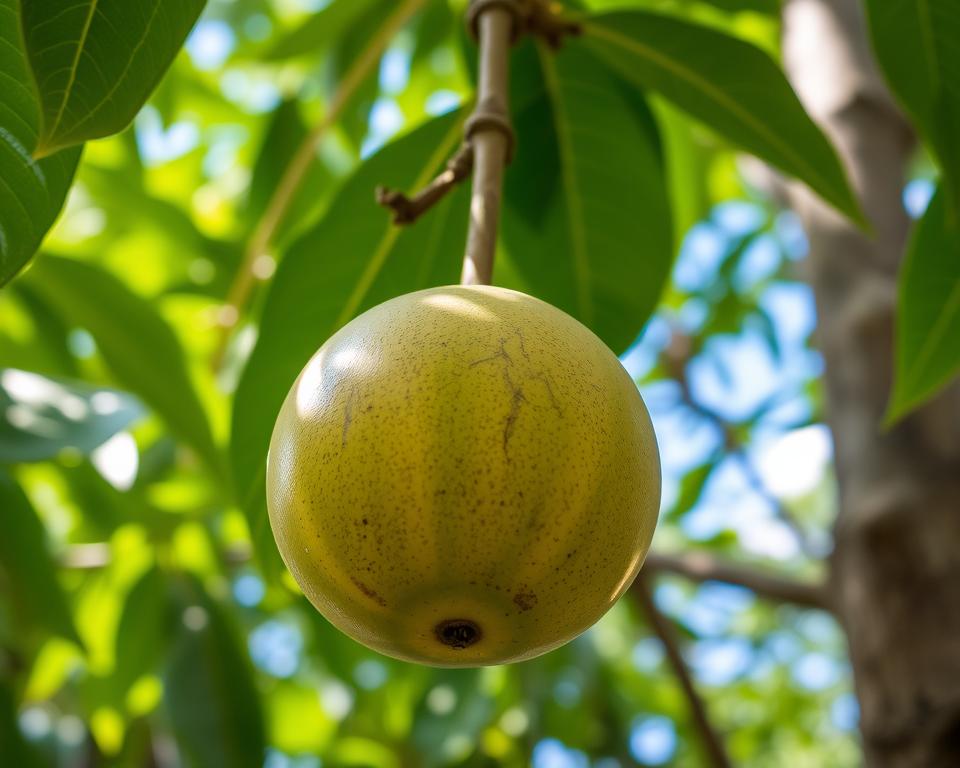The kaffir lime, also known as the makrut lime or combava, is a key citrus fruit in Southeast Asian cooking. It’s known for its unique smell and taste. This makes it a must-have in many dishes. We’ll look into its origins, how it’s used in cooking, its health perks, and its cultural importance.
Read interesting things at : tosawakan
Key Takeaways
- Kaffir lime is a fragrant citrus fruit widely used in Southeast Asian cuisine
- It has a distinctive aroma and flavor that adds complexity to various dishes
- Kaffir lime is a staple ingredient in traditional Thai, Indonesian, and Malaysian cuisines
- The leaves, zest, and juice of the kaffir lime are all utilized in cooking
- Kaffir lime offers various health benefits, including antioxidant and antimicrobial properties
What is a Kaffir Lime?
The kaffir lime, known as Citrus hystrix, is a special citrus fruit. It’s a type of the Mauritius papeda. This small lime is loved in Southeast Asian cooking for its unique taste and smell.
Origins and Taxonomy
The kaffir lime, also called the leech lime, comes from Thailand, Indonesia, and Malaysia. It’s part of the Rutaceae family, which includes oranges, lemons, and limes. The Citrus hystrix tree grows up to 15 feet tall and is evergreen.
Distinctive Aroma and Flavor
The kaffir lime is known for its special smell and taste. Its rough, dark green skin and leaves give off a strong, complex flavor. When you zest or crush it, you get a scent like lemon, pine, and eucalyptus.
The fruit’s juice and flesh also taste tart and citrusy. This makes it a key ingredient in many dishes.
“The kaffir lime is a true gem in the world of Southeast Asian cuisine, adding a depth of flavor that is simply unmatched by any other citrus fruit.”
Culinary Uses of Kaffir Lime
Kaffir lime is key in Southeast Asian cooking. Its unique citrus taste and smell are found in Thai cuisine, Malaysian cuisine, Indonesian cuisine, and Vietnamese cuisine.
Traditional Southeast Asian Cuisines
In Thai cuisine, kaffir lime leaves add a special scent to curries, soups, and stir-fries. The zest or juice goes into marinades, dipping sauces, and spice pastes. It’s a must-have in dishes like Tom Yum Goong, Massaman Curry, and Larb.
In Malaysian cuisine, kaffir lime leaves bring a unique aroma to coconut-based curries like Rendang and Gulai. They’re also in Nasi Goreng, a fried rice dish, and Laksa, a spicy noodle soup.
In Indonesian cuisine, kaffir lime leaves are used in many dishes, like Sayur Asem, a sour vegetable soup, and Nasi Campur, a mixed rice dish. The zest is mixed into spice pastes and marinades too.
In Vietnamese cuisine, kaffir lime leaves are often in soups, such as Pho, and marinades for grilled meats and seafood. The zest adds a fresh citrus taste to dipping sauces and dressings.
Modern Fusion Dishes
Recently, kaffir lime has become popular in modern fusion dishes worldwide. Chefs use its unique flavor in various cuisines, creating new and exciting dishes.
Kaffir lime is now in everything from cocktails to desserts and baked goods. Its versatility has caught the attention of culinary innovators who love to mix up traditional flavors.
Kaffir Lime Leaves: A Versatile Ingredient
Kaffir lime leaves, also known as makrut leaves, are key in Southeast Asian cooking. They add a unique and fragrant touch to many dishes. These leaves have a citrusy smell and taste, making them great for both traditional and new recipes.
People use kaffir lime leaves fresh or dried in Thai, Indonesian, and Malaysian cooking. They add a special citrus flavor to curries, soups, stir-fries, and marinades. This flavor enhances the taste of other ingredients.
| Culinary Uses of Kaffir Lime Leaves | Flavor Profile |
|---|---|
|
|
Kaffir lime leaves are also very versatile. You can use them fresh, dried, or frozen. This means you can enjoy their unique taste all year. They fit well in many dishes, from traditional Southeast Asian meals to modern fusion dishes. They are a must-have for any kitchen.
“Kaffir lime leaves are the secret weapon in many Thai and Malaysian dishes, adding a bright, citrusy flavor that is impossible to replicate with other ingredients.”
Kaffir Lime Zest and Juice
The kaffir lime fruit is more than just its vibrant green leaves. It has zest and juice that are full of flavor. These parts can make many dishes taste better.
Unique Citrus Notes
The zest of the kaffir lime is known for its strong, fragrant citrus taste. It adds a bright, aromatic touch to both sweet and savory dishes. The juice has a bold, tart taste that wakes up the palate.
Using the zest and juice of the kaffir lime can make a big difference in cooking. They can add a subtle flavor or be the main taste in dishes. These parts of the kaffir lime are essential for any kitchen.
“The zest of the kaffir lime is like a burst of sunshine, infusing dishes with a vibrant, aromatic citrus essence that is truly unique.”
Using kaffir lime zest and juice can take your cooking to new heights. It brings a touch of the exotic to both traditional and modern dishes. Home cooks and chefs can make their dishes stand out with this special citrus.
Growing Kaffir Lime Trees
The kaffir lime tree is a key part of Southeast Asian cooking. It grows well in warm, humid places with lots of sunlight. But, growing these citrus trees needs careful attention and the right conditions.
Climate Requirements
Kaffir lime trees love warm, moist places with plenty of sun. They can handle temperatures from 50°F to 95°F (10°C to 35°C). The best climate is like their home in Southeast Asia.
They need soil that drains well to avoid root rot. They do best in soil that’s a bit acidic to neutral.
Cultivation and Care
Starting kaffir lime trees from seed is hard. They usually grow from cuttings or air layering. Once they start growing, they need regular pruning.
This keeps them bushy and helps them make tasty leaves and fruit.
These trees need steady moisture but can’t sit in waterlogged soil. Feeding them a balanced, slow-release fertilizer helps them grow strong and full of leaves.
| Cultivation Requirement | Ideal Condition |
|---|---|
| Climate | Tropical to subtropical, with temperatures between 50°F to 95°F (10°C to 35°C) |
| Soil | Well-draining, acidic to neutral pH |
| Sunlight | Full sun, at least 6 hours per day |
| Propagation | Cuttings or air layering, not easily grown from seed |
| Pruning | Regular pruning to maintain compact, bushy shape |
| Irrigation | Consistent moisture, but well-draining soil |
| Fertilization | Balanced, slow-release formula |
Growing kaffir lime trees is both rewarding and challenging. By knowing what kaffir lime cultivation needs, gardeners can succeed with this fragrant citrus plant.
Substitutes for Kaffir Lime
The unique aroma and flavor of kaffir lime are key in many Southeast Asian dishes. But sometimes, finding this citrus fruit can be hard. In these cases, cooks and chefs can use kaffir lime substitutes to get close to the real taste.
One good lime leaves substitute is regular lime leaves. They can replace kaffir lime leaves in many recipes, even if they don’t taste exactly the same. Another option is mixing lime zest and lemongrass. This combo can give a similar bright, aromatic flavor to kaffir lime.
| Kaffir Lime Substitute | Ratio | Ideal Uses |
|---|---|---|
| Regular Lime Leaves | 1:1 | Curries, Soups, Stir-Fries |
| Lime Zest + Lemongrass | 1 tsp zest + 1 tbsp lemongrass | Marinades, Dressings, Sauces |
These kaffir lime substitutes can give a similar taste, but they won’t be the same as the real thing. You might need to adjust the recipe and taste it to get it just right.

“When kaffir lime is not available, a combination of lime zest and lemongrass can add the same bright, citrusy notes to your dish.”
Health Benefits of Kaffir Lime
Kaffir lime is more than just a unique flavor in dishes. It’s a vibrant green fruit full of vitamins, minerals, and antioxidants. These nutrients support overall health and well-being.
Nutritional Profile
Kaffir lime is packed with kaffir lime health benefits and kaffir lime nutrition. It’s a great source of vitamins C and A. These vitamins help boost the immune system and keep skin and vision healthy. Plus, it has minerals like calcium, iron, and magnesium.
- High in Vitamins C and A
- Good source of calcium, iron, and magnesium
- Contains antioxidants that may help fight free radicals
Research shows that kaffir lime’s antioxidants could fight inflammation, bacteria, and even cancer. These compounds protect the body from health problems and improve well-being.
“Kaffir lime is a nutritional powerhouse that offers a range of health benefits beyond its flavorful contribution to Asian cuisines.”
Adding kaffir lime and its leaves to your meals is easy and tasty. It boosts your nutrient intake and may offer health benefits. This citrus fruit is great for a healthy, balanced diet, whether in traditional or modern dishes.
Kaffir Lime in Beverages and Cocktails
The kaffir lime is not just for cooking. It shines in beverages and cocktails too. Its unique citrusy aroma and zesty flavor make it perfect for many drinks. From kaffir lime drinks to kaffir lime cocktails, it adds something special.
Kaffir lime can make any drink better, from gin cocktails to rum drinks. You can use the leaves, zest, and juice to give drinks a unique taste. This makes both drinks with alcohol and those without stand out.
Kaffir Lime Drinks
- Kaffir Lime Cooler: A refreshing mocktail featuring kaffir lime leaves, ginger, and soda water.
- Kaffir Lime Lemonade: A tart and tangy lemonade with a twist of kaffir lime zest.
- Kaffir Lime Iced Tea: Brewed tea infused with kaffir lime leaves for a distinctive citrus aroma.
Kaffir Lime Cocktails
- Kaffir Lime Martini: A sophisticated take on the classic martini, featuring kaffir lime-infused gin.
- Kaffir Lime Mojito: A tropical twist on the mojito, with kaffir lime leaves and juice.
- Kaffir Lime Margarita: A zesty margarita with kaffir lime juice and a rim of kaffir lime salt.
| Kaffir Lime Drink | Key Ingredients | Flavor Profile |
|---|---|---|
| Kaffir Lime Cooler | Kaffir lime leaves, ginger, soda water | Bright, herbaceous, and refreshing |
| Kaffir Lime Lemonade | Kaffir lime zest, lemon juice, sugar | Tart, tangy, and citrusy |
| Kaffir Lime Martini | Kaffir lime-infused gin, dry vermouth | Sophisticated, aromatic, and herbaceous |
Kaffir lime is a game-changer in drinks, making even simple ones special. It’s perfect for adding a zesty twist to classics or creating new, exciting flavors. The kaffir lime is a must-try for anyone looking to spice up their drinks.
Storing and Preserving Kaffir Lime
Keeping kaffir lime fresh is key to using its full flavor. You can store and preserve it in several ways, whether it’s the leaves or the fruit. This method helps keep its unique taste for longer.
Fresh Kaffir Lime
To keep fresh kaffir lime leaves and fruit, store them in the fridge. Put them in a resealable bag or airtight container. They can last about a week this way. For even longer storage, freeze them.
Wash and dry the leaves or fruit first. Then, put them in a freezer-safe bag or container. They can stay good for several months in the freezer.
Dried Kaffir Lime
Drying kaffir lime leaves is a great way to preserve them for a long time. This method makes their flavor stronger. To dry them, wash and dry the leaves, then lay them out on a baking sheet.
Let them dry in a cool, dry place with good air flow. They should be dry and crisp in a few days. Once dry, store them in an airtight container in a cool, dark place. They can last up to a year.
| Storage Method | Shelf Life | Considerations |
|---|---|---|
| Refrigerated Fresh Kaffir Lime | Up to 1 week | Store in a resealable bag or airtight container |
| Frozen Fresh Kaffir Lime | Up to 6 months | Wash and dry before freezing |
| Dried Kaffir Lime Leaves | Up to 1 year | Arrange in a single layer to dry thoroughly |
Knowing how to store and preserve kaffir lime is key. This lets you always have it ready to add flavor to your dishes. Whether you choose fresh, frozen, or dried kaffir lime, keep its strong aroma and citrus taste.
Kaffir Lime in Desserts and Confections
Kaffir lime is often thought of in savory dishes, but it’s great in sweet treats too. It adds a unique aroma and flavor to desserts. These can range from light kaffir lime desserts to rich kaffir lime sweets.
Adding kaffir lime zest or juice to desserts can make them special. It turns simple desserts like kaffir lime cheesecake or kaffir lime pound cake into something new. It also goes well with tropical tastes, making kaffir lime sorbet or kaffir lime panna cotta a treat.
Kaffir lime can also be used to make unique sweets. Think kaffir lime macarons, kaffir lime truffles, or kaffir lime-infused marshmallows. The leaves can be used to make syrups and toppings for desserts like kaffir lime popsicles or kaffir lime-glazed donuts.
| Kaffir Lime Dessert | Description |
|---|---|
| Kaffir Lime Cheesecake | A rich and creamy cheesecake infused with the zest and juice of kaffir lime, offering a tantalizing balance of tart and sweet. |
| Kaffir Lime Pound Cake | A classic pound cake elevated with the fragrant notes of kaffir lime, creating a delightfully citrusy treat. |
| Kaffir Lime Sorbet | A refreshing and light sorbet that showcases the bright, floral flavors of kaffir lime, perfect for a palate-cleansing dessert. |
| Kaffir Lime Macarons | Delicate French macarons infused with the distinctive aroma of kaffir lime, resulting in a uniquely flavored confection. |
Kaffir lime is a versatile ingredient that adds a special citrus twist to desserts. It can be used in cakes, cookies, or frozen treats. This unique Asian citrus can make any sweet treat stand out.
Cultural Significance of Kaffir Lime
The kaffir lime is a unique citrus fruit found in Southeast Asian cuisine. It is more than just a food item; it has deep cultural roots in many Asian countries. This fruit is valued for its symbolic and spiritual importance.
In traditional beliefs, kaffir lime leaves are used for purification rituals. They are thought to cleanse and protect people. These leaves are also used in religious offerings and to make natural remedies and incense. This shows the high respect for the kaffir lime in the region.
The kaffir lime’s unique look, with its wrinkled skin and special leaves, gives it symbolic meaning. In Thai and Indonesian cultures, it’s seen as a symbol of good luck, wealth, and fertility. It’s often used in decorations and celebrations for these reasons.
“The kaffir lime is not just a culinary ingredient – it’s an integral part of our cultural heritage and traditions.”
— Chef Pailin Chongchitnant, author of “Hot Thai Kitchen”
The kaffir lime’s importance goes beyond just cooking. It shows the deep respect and love for this Asian citrus fruit in the region’s diverse cultures.
Buying and Sourcing Kaffir Lime
Kaffir lime is a citrus fruit known for its strong scent and zest. It might not be easy to find everywhere, but it’s worth the search. Home cooks and chefs can find it in various places, making it easy to use in cooking.
Looking for where to buy kaffir lime? Check out local Asian or specialty grocery stores. These places usually have a wide selection of exotic fruits and vegetables, including kaffir lime. Make sure to pick fresh, bright leaves and unblemished fruit for the best results.
If you can’t find kaffir lime locally, online stores are a good option. They offer a wide range of products, from fresh leaves to dried zest. This makes it easy for anyone to get this important Asian ingredient.
| Purchasing Option | Availability | Convenience | Quality Assurance |
|---|---|---|---|
| Local Asian/Specialty Grocery Stores | Varies by region | In-person selection and immediate access | Ability to inspect produce for freshness |
| Online Retailers | Widely available | Convenient delivery to your doorstep | Reputable vendors ensure quality products |
Whether you buy kaffir lime locally or online, focus on getting high-quality, fragrant leaves. With some effort, this key Asian ingredient can be added to many dishes. It can make your meals go from ordinary to extraordinary, from traditional dishes to modern creations.

Conclusion
Kaffir lime is a citrus fruit with a unique essence. It comes from Southeast Asia and is used in many cuisines. This fruit adds a special touch to dishes with its aroma and flavor.
It’s not just for cooking; kaffir lime is also good for health. It’s a great addition to any diet. Plus, it’s important in Asian cultures, showing its deep cultural value.
Learning about kaffir lime helps cooks at home and in restaurants. They can explore new flavors and dishes. Kaffir lime is key in Asian cuisine, adding to both savory and sweet dishes.










